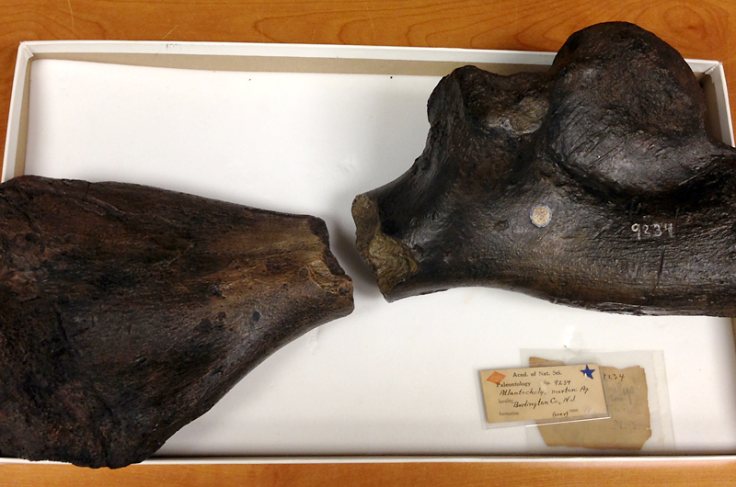Two Fossils Belonging To The Same Turtle Bone Found Centuries Apart, Halves Fit Like ‘Puzzle Pieces’ [PHOTO]

An amateur fossil hunter may have solved a piece to a very ancient puzzle.
Gregory Harpel was at his usual fossil-hunting haunt at a brook in Monmouth County, N.J., when he stumbled on something that resembled a rock. Upon closer examination, he decided to bring it to the New Jersey State Museum. A paleontologist there believed the fossil belonged to the same sea turtle species he remembered seeing at the Academy of Natural Sciences in Philadelphia. When the two specimens were brought together they fit together like a jigsaw puzzle revealing they belonged to the same animal, the Philadelphia Inquirer reports.
“As soon as those two halves came together, like puzzle pieces, you knew it,” Dr. Ted Daeschler, from the Academy of Natural Sciences of Drexel University, said in a statement.
The findings will be announced Tuesday by David Parris, a paleontologist at the New Jersey State Museum.
The fossils belong to the Atlantochelys mortoni, one of the largest sea turtles that ever lived. With the complete 21-inch bone, scientists were able to estimate the size of the reptile – approximately 10 feet from head to tail that swam in the shallow ocean waters in modern New Jersey’s Monmouth County more than 70 million years ago.
The first fossil was unearthed by naturalist Louis Agassiz in 1846. At the time, the description said it was picked up in New Jersey. When Gregory Harpel found the other half in Monmouth County, scientists were able to narrow down where the sea turtle lived.
"Scientifically, we now know a lot more about this creature,” Dr. Ted Daeschler, from the Academy of Natural Sciences of Drexel University told the BBC. "Most importantly, we now know precisely which rock formation the original came out of, and so we can more precisely know its age, and we can be much more confident about finding additional material in that same formation and therefore telling more about A. mortoni."
From their analysis, the scientists believe the turtle bone was buried during a time when New Jersey was covered in water during the Cretaceous period. The bone later eroded, causing it to split into two pieces.
When amateur fossil hunter Gregory Harpel came across the second piece of the bone, he didn’t think much of it.
Initially, I thought it was just a stream rock," Harpel said. "The more I looked at it, it had a definitive shape to it."
Now that the two pieces will be on display at the New Jersey State Museum, Harpel says he’s happy that his instincts led to a discovery.
"It's all fate and circumstances that drew me to find it in the first place," he said. "It belongs to the public. It doesn't need to be sitting in a drawer in my house."
© Copyright IBTimes 2025. All rights reserved.






















